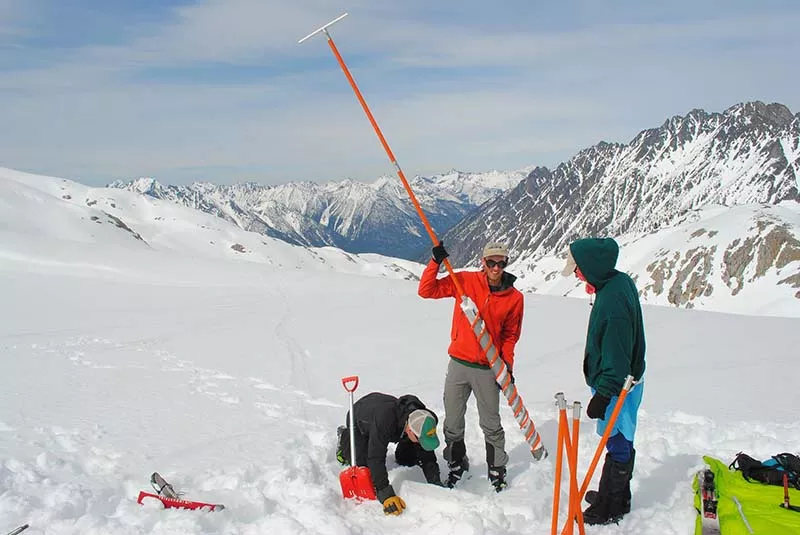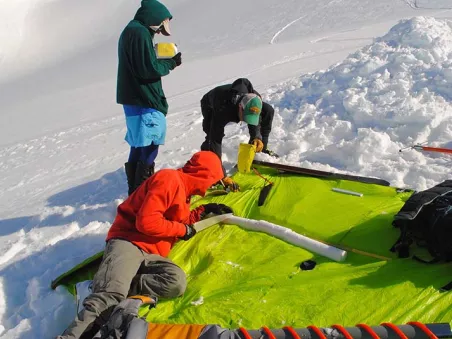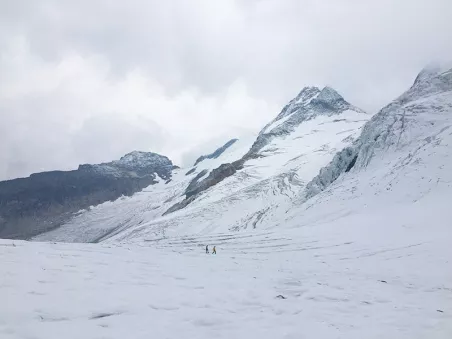UNBC PhD candidate measures glacier mass change in Columbia River basin
UNBC PhD candidate Ben Pelto and his research team performed a multi-year evaluation of glaciers in the Columbia and Rocky Mountains. Their seasonal field measurement of winter snowfall and summer melt, complemented with aerial surveying, provide an accurate glimpse of glacier mass change. These estimates can be used to predict future glacier response to climate change.

For Ben Pelto, a study in glacier changes compares to a bank account. For example, a bank account that is losing money is like a retreating glacier. Snowfall during the winter months is like depositing money into the bank account, and snowmelt during warmer weather is like making a withdrawal. Pelto, a PhD candidate in the Geography Program at the University of Northern British Columbia, wanted to track just how much change was taking place in glacier mass in the Columbia River basin.
“Changes in glacier mass are the direct response to meteorological conditions during the accumulation and melt seasons,” Pelto explains. “We derived multi-year, seasonal mass balance from airborne laser scanning surveys and compared them to field measurements for six glaciers in the Columbia and Rocky Mountains.”
Pelto says more than 40 volunteers participated in the multi-year evaluation, which took place over 11 field seasons and totaled close to 250 days spent on glaciers. His team visited six glaciers twice per year to measure winter snowfall and summer snow and ice melt. They also used an airborne laser scanner to produce detailed maps, and captured 100 glaciers per season.
The Pelto team’s estimates of glacier mass change from both the aerial surveying and field measurements aligned with the results, revealing that this type of study can be scaled up to a larger glacier sample. “We are providing the first large dataset of seasonal glacier mass change for the Canadian Columbia River basin. These estimates are valuable as calibration and validation data for glacier models, better allowing us to predict future glacier response to climate change and runoff from these glaciers as they continue to shrink.”
“Knowing how much glaciers contribute to streamflow today is important for understanding how the ecosystems they support, and services they provide, will fare when the glaciers are gone or greatly reduced in size,” says Pelto.
“The Columbia River basin benefits from glacier runoff from the 2200 glaciers in the basin, yet estimates of glacier mass change within the basin were not available,” Pelto says about why the study was needed. With a focus on a regional area and seasonal glacier mass change, this study builds on an earlier research project led by Pelto’s PhD supervisor, Brian Menounos, who is a UNBC geography Professor and Canada Research Chair in Glacier Change. That study, released in January of 2019 in Geophysical Research Letters, used satellite images over the past 20 years to track glacier mass change in Western North America. Pelto sums up the differences between the two studies by expressing that each study is asking a different question.
The results of the field study were recently published online in The Cryosphere, an interactive open-access journal of the European Geosciences Union. The study includes collaborators Brian Menounos and Shawn J. Marshall from the University of Calgary.

